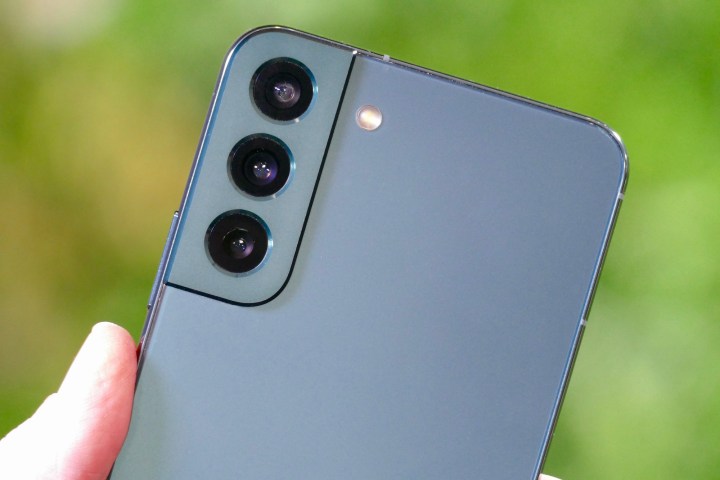The OnePlus 10 Pro undercuts several thousand-dollar flagships at an $899 selling price. While it isn’t fair to compare the OnePlus device with the top-of-the-line Galaxy S22 Ultra, the Galaxy S22 Plus is its direct competitor — and they’re two of the best Android smartphones that you can purchase today. But if you have $900 to $1,000 to spend, which of the two flagships should you buy? To help you answer the question, here is a comparison that pits the OnePlus 10 Pro against the Samsung Galaxy S22 Plus.
Specs
| OnePlus 10 Pro | Samsung Galaxy S22 Plus | |
| Size | 163 x 73.9 x 8.6mm (6.42 x 2.91 x 0.34 inches) | 157.4 x 75.8 x 7.6mm (6.20 x 2.98 x 0.30 inches) |
| Weight | 201 grams | 196 grams |
| Display | 6.7-inch AMOLED | 6.6-inch AMOLED |
| Screen resolution | 1440 x 3216 pixels (525 pixels per inch) | 1080 x 2340 pixels (393 ppi) |
| Operating system | Android 12, OxygenOS 12.1 | Android 12, OneUI 4.1 |
| Storage space | 128GB, 256GB | 128GB, 256GB |
| MicroSD card slot | No | No |
| Processor | Qualcomm Snapdragon 8 Gen 1 | Qualcomm Snapdragon 8 Gen 1 |
| RAM | 8GB, 12GB | 8GB |
| Camera | 48-megapixel wide, 50MP ultrawide, 8MP telephoto rear 32MP front |
50MP wide, 12MP ultrawide, 10MP telephoto rear 10MP front |
| Video | 8K at 24 frames per second, 4K at 30/60/120 fps, 1080p at 30/60/240 fps | 4K at 30/60 fps, 1080p at 30 fps |
| Bluetooth version | Bluetooth 5.2 | Bluetooth 5.2 |
| Ports | USB-C | USB-C |
| Fingerprint sensor | Yes, in-display | Yes, in-display |
| Water resistance | No | Yes |
| Battery | 5,000mAh | 4,500mAh |
| App marketplace | Google Play Store | Google Play Store |
| Network support | T-Mobile | All major carriers |
| Colors | Volcanic Black, Emerald Forest | Phantom Black, white, Pink Gold, green, Graphite, Sky Blue, Violet, Cream |
| Price | $899 | $999 |
| Buy from | T-Mobile | Samsung |
| Review score | 4 out of 5 stars | 4 out of 5 stars |
Design and display
- 2. Samsung Galaxy S22 Plus
At 8.6mm thick and 200 grams, the OnePlus 10 Pro feels chunky, premium, and confidence-inspiring. The device reflects the excellent build quality of Gorilla Victus on the front and Gorilla Glass 5 on the back. It comes in two color options, Emerald Forest and Volcanic Black. It comes with a frosted finish that provides a good grip and is resistant to fingerprints.
By contrast, the Samsung
Coming to the display, the OnePlus 10 Pro features a 6.7-inch AMOLED display with support for a dynamic 120Hz refresh rate, 1,300 nits peak brightness, and a 525 pixels-per-inch (ppi) density. It is very similar to the one on the OnePlus 9 Pro. The screen never fails to startle with bright, deep colors. It is a beautiful display.
The Samsung phone sports a slightly smaller 6.6-inch screen. Like the OnePlus 10 Pro, the
With a sharper resolution, we give the edge to the OnePlus 10 Pro over the
Winner: OnePlus 10 Pro
Performance, battery life, and charging

Both the OnePlus 10 Pro and Samsung Galaxy S21 Plus are powered by the Qualcomm Snapdragon 8 Gen 1 processor in the U.S. Both devices fly through daily tasks, and you’ll notice no difference while using the phones in daily life. The top OnePlus 10 Pro variant has 12GB
The OnePlus
With the same performance, a bigger battery, and faster charging, the OnePlus 10 Pro takes the cake in the performance and battery segment.
Winner: OnePlus 10 Pro
Camera
- 1. OnePlus 10 Pro camera
- 2. Galaxy S22 Plus camera module
OnePlus 10 Pro sports a 48-megapixel main camera, a 50MP wide-angle camera with a 110-degree field of view, and an 8MP telephoto for a 3.3x optical zoom. There’s also a special 150-degree wide-angle camera mode. The
The OnePlus 10 Pro camera masterfully balances the effect of
The
With equally capable cameras and the presence of ultrawide and telephoto lenses on both smartphones, the camera segment is a tie.
Winner: Tie
Software and update

The OnePlus 10 Pro and the
Samsung wins this segment purely on the basis of its promises and the knack for keeping them. While OnePlus struggles to roll out updates for its flagship devices, software patches hit Samsung flagship smartphones within the first two days of the month. Moreover, Samsung promises four years of software updates and five years of security patches, so the
Winner: Samsung
Price and availability
The OnePlus 10 Pro is now available for purchase and costs $899 for the 8GB, 128GB model, while the 12GB, 256GB version will follow its release at a later date. It is exclusively available on T-Mobile. You can purchase the phone through Amazon and OnePlus globally. The
Overall winner: OnePlus 10 Pro

The OnePlus 10 Pro features a sharp AMOLED display, the same Snapdragon 8 Gen 1 processor, capable cameras, and faster charging when compared to the Galaxy S22 Plus. While OnePlus has made no promises on the software updates, you should expect to receive at least two major OS updates. It undercuts the
Editors' Recommendations
- Best Samsung Galaxy S22 deals: Save big on unlocked models
- Best Samsung Galaxy deals: S24, Buds, Watches and more
- A new version of the Samsung Galaxy S24 could be coming soon
- Best Samsung Galaxy S24 deals: Save up to $800 on the phone
- Best Samsung Galaxy S23 Ultra deals: How to get the phone for free







